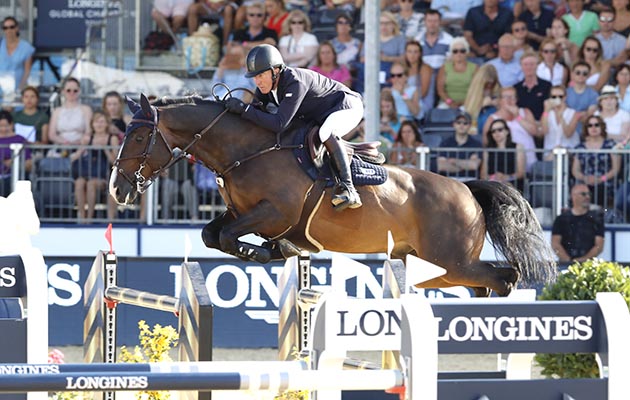In a career spanning over 40 years, Michael has won 15 championship medals, including team silver at the 1984 Olympics and four team golds at the Europeans. He has claimed some of the world’s most prestigious grands prix and the Hickstead Derby title four times.
There were so many great riders in my younger days to watch and learn from – Eddie Macken, David Broome, Malcolm Pyrah and Caroline Bradley – but my mum said, “Watch Harvey Smith, his legs don’t move.” And she was right – he sat in a really good place and was actually a very stylish rider. Horses always went well for him and he set a great example to me.
I grew up watching Harvey jump in Yorkshire, then I’d see him and David Broome at Horse of the Year Show (HOYS), Olympia and Hickstead, and they became my idols. David was winning a lot but he never looked like he was in a rush in a jump-off – he would never flap about, everything looked under control.
{"content":"PHA+SSBzYXkgdGhlIHNhbWUgdG8gbXkgc29uIEphY2sgbm93IHdoZW4gaGUgZ29lcyBvZmYgdG8gc2hvd3Mg4oCTIGdvIGFuZCB3YXRjaCBhbGwgdGhlIHRvcCByaWRlcnMgd2hlbmV2ZXIgeW91IGNhbiwgdG8gc2VlIGhvdyB0aGV5IGRvIGl0LiBBIGxvdCBvZiBraWRzIG5vdyBqdXN0IGp1bXAgdGhlaXIgY2xhc3MgYW5kIGdvLCBidXQgdGhlIGJlc3QgbGVzc29uIHlvdSBjYW4gaGF2ZSBpcyB0byB3YXRjaCBhbmQgbGVhcm4uPC9wPgo8aDM+VGhlIGltcG9ydGFuY2Ugb2YgcmlkZXIgcG9zaXRpb248L2gzPgo8cD5XaGVuIEkgd2FzIHlvdW5nLCBJIHdpc2ggSeKAmWQgYXBwcmVjaWF0ZWQgdGhlIGltcG9ydGFuY2Ugb2YgbXkgcG9zaXRpb24gaW4gdGhlIHNhZGRsZS4gVXAgdG8gdGhlIGFnZSBvZiBhYm91dCAxNiwgYWxsIEkgd2FzIHRoaW5raW5nIGFib3V0IHdhcyBnb2luZyBpbiB0aGUgcmluZyBhbmQgd2lubmluZyDigJMgaXQgZGlkbuKAmXQgbWF0dGVyIGhvdyBJIGxvb2tlZCBhcyBsb25nIGFzIEkgZGlkIGl0LiBCdXQgYXMgSSBnb3Qgb2xkZXIgYW5kIHRoaW5ncyBiZWNhbWUgbW9yZSBkaWZmaWN1bHQgSSByZWFsaXNlZCBob3cgbXVjaCBzaXR0aW5nIGluIHRoZSByaWdodCBwbGFjZSBhdCB0aGUgcmlnaHQgdGltZSBjYW4gaGVscCB0aGUgaG9yc2UuIFRoZSByZWFzb24gdGhlIEFtZXJpY2FuIHJpZGVycyBkbyBzbyB3ZWxsIG1vc3Qgb2YgdGhlIHRpbWUgaXMgYmVjYXVzZSB0aGV5IHNpdCBpbiBleGFjdGx5IHRoZSByaWdodCBwbGFjZS48L3A+CjxwPkEgdGlwIEhhcnZleSB0YXVnaHQgbWUgd2FzIG5vdCB0byBqdW1wIHRvbyBiaWcgb3IgdG9vIG11Y2ggaW4gdGhlIHdhcm0tdXAuIFlvdSBuZWVkIHRvIGdvIGludG8gdGhlIHJpbmcgZnVsbCBvZiBjb25maWRlbmNlLCBub3QgaGF2aW5nIGp1c3QgaGFkIGEgY3Jhc2ggb3IgYSBzdG9wLCBzbyB5b3UgbXVzdG7igJl0IG92ZXJqdW1wIHlvdXIgaG9yc2UuPC9wPgo8cD48ZGl2IGNsYXNzPSJhZC1jb250YWluZXIgYWQtY29udGFpbmVyLS1tb2JpbGUiPjxkaXYgaWQ9InBvc3QtaW5saW5lLTIiIGNsYXNzPSJpcGMtYWR2ZXJ0Ij48L2Rpdj48L2Rpdj48c2VjdGlvbiBpZD0iZW1iZWRfY29kZS0zMSIgY2xhc3M9ImhpZGRlbi1tZCBoaWRkZW4tbGcgcy1jb250YWluZXIgc3RpY2t5LWFuY2hvciBoaWRlLXdpZGdldC10aXRsZSB3aWRnZXRfZW1iZWRfY29kZSBwcmVtaXVtX2lubGluZV8yIj48c2VjdGlvbiBjbGFzcz0icy1jb250YWluZXIgbGlzdGluZy0tc2luZ2xlIGxpc3RpbmctLXNpbmdsZS1zaGFyZXRocm91Z2ggaW1hZ2UtYXNwZWN0LWxhbmRzY2FwZSBkZWZhdWx0IHNoYXJldGhyb3VnaC1hZCBzaGFyZXRocm91Z2gtYWQtaGlkZGVuIj4NCiAgPGRpdiBjbGFzcz0icy1jb250YWluZXJfX2lubmVyIj4NCiAgICA8dWw+DQogICAgICA8bGkgaWQ9Im5hdGl2ZS1jb250ZW50LW1vYmlsZSIgY2xhc3M9Imxpc3RpbmctaXRlbSI+DQogICAgICA8L2xpPg0KICAgIDwvdWw+DQogIDwvZGl2Pg0KPC9zZWN0aW9uPjwvc2VjdGlvbj48L3A+CjxwPknigJl2ZSBhbHNvIGxlYXJudCBub3QgdG8gbG9zZSBwYXRpZW5jZSB3aXRoIGEgaG9yc2UuIFdl4oCZcmUgYWxsIGd1aWx0eSBvZiBpdCwgYnV0IHlvdSBuZWVkIHRvIGJyZWF0aGUgaW4sIGNvdW50IHRvIDEwIGFuZCBzdGFydCBhZ2FpbiDigJMgc29tZXRpbWVzIHlvdSBjYW4gZmFsbCBvdXQgd2l0aCBhIGhvcnNlLCBidXQgeW91IGdpdmUgeW91cnNlbGYgYSBsb3QgbW9yZSB3b3JrIHRyeWluZyB0byBwdXQgdGhpbmdzIGJhY2sgdG9nZXRoZXIgYWdhaW4gdGhlIG5leHQgZGF5LjwvcD4KPGgzPldoZXJlIGRvIEkgc3RhcnQ\/PC9oMz4KPHA+VGhlIGxhc3QgdGhpbmcgSSB0cnkgdG8gcmVtZW1iZXIgd2hlbiBJIGdvIGludG8gdGhlIGFyZW5hIGlzIHdoZXJlIHRoZSBmaXJzdCBmZW5jZSBpcyDigJMgc28gb2Z0ZW4sIHlvdSBjYW4gaGF2ZSBhIGNvbXBsZXRlIGJsYW5rIGFib3V0IHRoZSBjb3Vyc2UgYW5kIGEgZmV3IHRpbWVzIEkgaGF2ZSB0aG91Z2h0LCDigJxPaCBibG9vZHkgaGVsbCwgd2hlcmUgZG8gSSBzdGFydD\/igJ0gQnV0IHVzdWFsbHkgaWYgeW91IGNhbiBzZWUgd2hlcmUgdGhlIGZpcnN0IGZlbmNlIGlzLCBpdCBhbGwgZmFsbHMgaW4gdG8gcGxhY2UhPC9wPgo8ZGl2IGNsYXNzPSJhZC1jb250YWluZXIgYWQtY29udGFpbmVyLS1tb2JpbGUiPjxkaXYgaWQ9InBvc3QtaW5saW5lLTMiIGNsYXNzPSJpcGMtYWR2ZXJ0Ij48L2Rpdj48L2Rpdj4KPHA+SSBoYXZlIGV2ZXJ5IHR5cGUgb2YgYml0IGluIG15IHRhY2sgcm9vbSBidXQgSSB0ZW5kIHRvIGdvIHRvIHRoZSBzYW1lIG9uZXMgdGltZSBhbmQgYWdhaW4g4oCTIHNuYWZmbGUsIGRvdWJsZSBicmlkbGUsIHZ1bGNhbml0ZSBwZWxoYW0gb3IgaGFja2Ftb3JlLiBCdXQgdGhlIHZ1bGNhbml0ZSBwZWxoYW0gd2l0aCB0b25ndWUgcG9ydCBpcyB0aGUgb25lIEkgdXNlIHRoZSBtb3N0LiBJdOKAmXMgYWN0dWFsbHkgbm90IHZlcnkgc3Ryb25nIHdpdGggYSByb3VuZGluZyBvbiBpdCBzbyBpZiBhIGhvcnNlIG1lc3NlcyB3aXRoIGl0cyB0b25ndWUgb3IgaXRzIG1vdXRoLCBJIHB1dCBpdCBvbiBhbmQgdGhleSBhY2NlcHQgaXQgcmVhbGx5IHdlbGwuIEl0IGN1dHMgb3V0IGEgbG90IG9mIHByb2JsZW1zLjwvcD4KPGRpdiBjbGFzcz0iaW5qZWN0aW9uIj48L2Rpdj4KPHA+SSB3aXNoIEkgaGFkIFdhcnJlbiBQb2ludCwgd2l0aCB3aG9tIEkgd29uIHRlYW0gZ29sZCBhdCB0aGUgMTk4NSBFdXJvcGVhbiBDaGFtcGlvbnNoaXBzLCBvbiBteSB5YXJkIG5vdy4gSGUgd2FzIHNvIGZhc3QgYWdhaW5zdCB0aGUgY2xvY2sgYW5kIHVuYmVsaWV2YWJseSBjYXJlZnVsLiBIZSBsaWtlZCBIaWNrc3RlYWQgYW5kIEFhY2hlbiwgYnV0IGhlIHdhcyBhbHNvIGdvb2QgaW5kb29ycyBhbmQgd29uIHRoZSBIT1lTIGdyYW5kIHByaXgsIHRvby4gSGUgaGFkIHNvdW5kbmVzcyBwcm9ibGVtcyBhdCB0aGUgZW5kLCBzbyBoaXMgY2FyZWVyIHdhcyBjdXQgc2hvcnQsIGJ1dCBJ4oCZZCBsb3ZlIHRvIHNlZSBoaW0gcmVhY2ggaGlzIGZ1bGwgcG90ZW50aWFsLjwvcD4KPHA+PGVtPlJlZiBIb3JzZSAmYW1wOyBIb3VuZDsgMzAgSnVseSAyMDIwPC9lbT48L3A+CjxwPgo="}
H&H showjumping editor
Jennifer is passionate at showjumping and her role as H&H’s showjumping editor has taken her around the world reporting from shows and interviewing riders, connections and those involved behind the scenes. Since joining H&H from BBC Sport in 2005, she has written on every subject across the equestrian sphere — from turnout rugs to stable management — and has interviewed gold medallists, world champions and winners galore. She also has first-hand experience of working in the equestrian industry as a riding instructor and yard manager.

